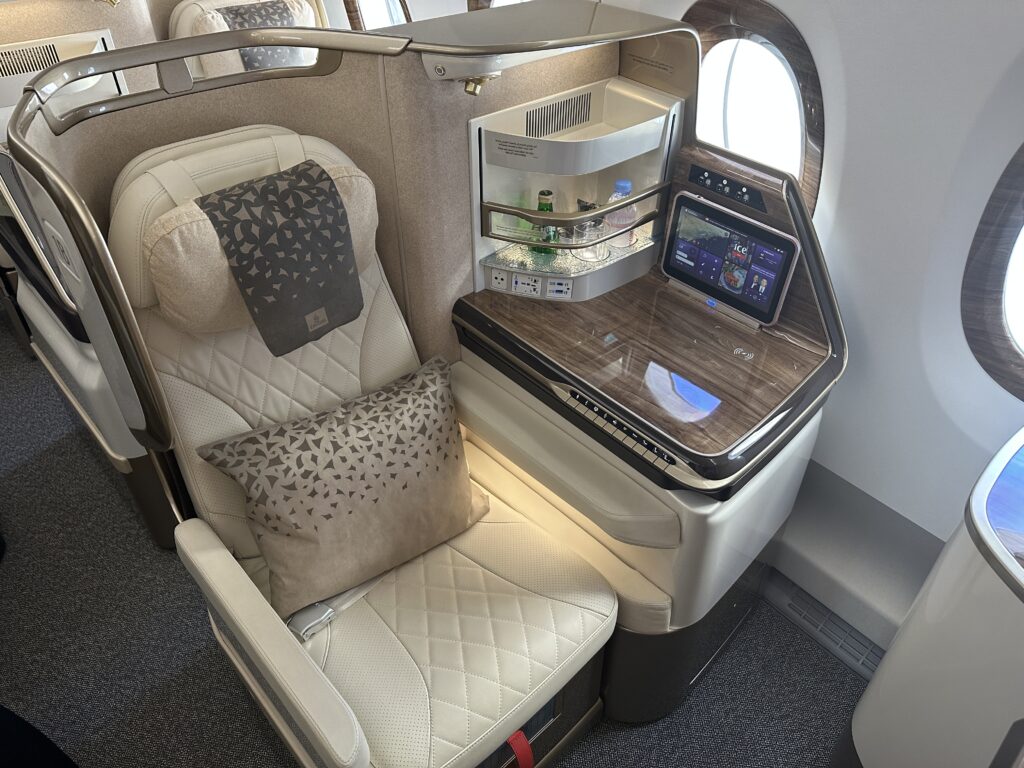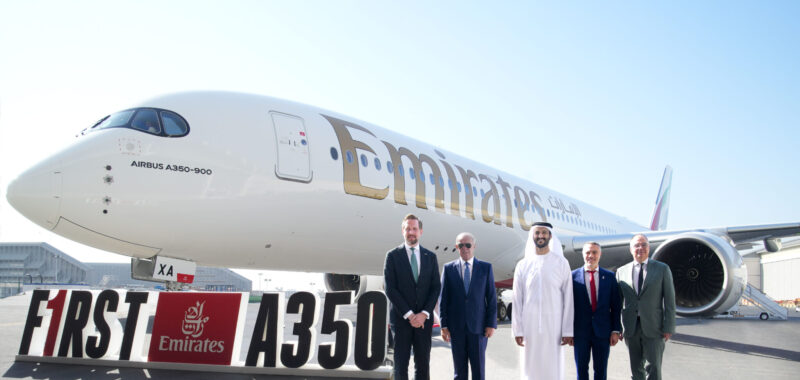The world has hundreds of international airlines, but only a select few can call themselves “super connectors.” These carriers channel huge amounts of traffic through a hub airport, resulting in an almost infinite combination of one-stop city pairings.
Alongside notable competitors such as Turkish Airlines, Emirates has leveraged its geographic position to bridge continents and gain the “super connector” title. However, unlike its Istanbul-based counterpart, Emirates operates just two aircraft types: the Airbus A380 and the Boeing 777. But that’s set to change, effective January 2025.
Emirates has 65 Airbus A350-900s, 30 Boeing 787s, and 205 Boeing 777Xs on order. The airline is also investing $4 billion in retrofitting 191 existing aircraft with new cabin interiors. This will extend their operating ability and tide the carrier over while new aircraft arrive to replace them.
Emirates’ First Airbus A350
On Monday, Emirates took delivery of the first of 65 A350 aircraft on order. The plane, bearing tail number A6-EXA, was flown from Toulouse to Dubai. Upon arrival in the UAE, it was presented to a select audience at the Emirates Engineering Center.
To describe the event as significant for Emirates is an understatement. It marked the airline’s first new aircraft type since 2008 when the first A380 was inducted.
The new planes are crucial for Emirates. Not only will they reduce dependency on older, less fuel-efficient jets, but they will also allow the airline to expand. Emirates initially ordered 50 A350s in 2019 and added another 15 to its order book last year.
“We are expansionist and we’ve had our wings clipped because of Covid and supply chains,” Emirates Airline President Sir Tim Clark told Skift and other media at the A350 launch event. “We are a frustrated entity because we need aeroplanes, and we need them now. We’re champing at the bit to try to activate our network and grow it considerably more than it is today. These aircraft coming into us are vital.”
Emirates – a large customer of 777X widebody planes – is unhappy with Boeing. While airline management, including Sir Tim, have publicly shared their displeasure over and over, the carrier is currently not reconsidering its 777X order.
“They [Boeing] have to sort out the current situation they’re in. I’m hoping that with the $21 billion they’ve just injected into the company and the end of the strike, that they’re now working over the next few months to sort out what they’re going to do. We watch that very closely,” said Sir Tim, who featured in the Skift Power Rankings 2024.
He took the opportunity to remind reporters that if Boeing had delivered the 777-9 to Emirates on time, it would have 85 of the next-generation aircraft by now.
The frustrations are not unique to Emirates. Speaking exclusively to Skift last month, Cathay Pacific CEO Ronald Lam described the 777X program as “a moving target.”
The entry of Emirates’ A350 into service has also been delayed in the current environment. The airline had set an arrival date of August 2024 for the first aircraft, which was ultimately pushed back by four months. The airline is hoping to induct another four planes by March 2025. The 65th and final delivery should be made before the end of 2028.
Where Will the Emirates A350 Fly?
The first nine destinations for the A350 have already been announced. These include Edinburgh, where the first A350 will fly from January 2025. Other European cities that will see the new plane include Lyon and Bologna.
The A350 roll-out is not limited to Europe. Mumbai, Ahmedabad, and Colombo will be the first locations in West Asia, while select services to Bahrain, Muscat, and Kuwait will soon see the European-built widebody.
Notably, not all Emirates A350s will be the same. The airline has opted for two distinct configurations, with 15 aircraft due for delivery without a crew rest area. These planes will fly “regionally,” which from Emirates’ perspective, means deep into Europe and Asia from its base in Dubai.
The remaining 50 will be equipped with a crew rest area, allowing them to fly even longer journeys. In practice, this will cover most parts of the world except some cities in Central and South America. This sub-fleet of planes is due to arrive at the airline from mid-2025.
The developments in Dubai came just 48 hours after Abu Dhabi-based rival Etihad Airways announced ten new routes for 2025.
Evolution, Not Revolution
Emirates has used the opportunity to upgrade, rather than overhaul, its existing business class product.
The airline has stuck with seating manufacturer Safran for the A350. The company also supplied the A380 and later enhancements to the 777. To the surprise of some, Emirates has decided against the trend of adding a privacy door to its business class seats. All of the 32 seats are open format with a 1-2-1 configuration.
Inspired by the Mercedes S-Class, the seats have white leather upholstery, faux wood, and gold trims. New elements include a wireless charging panel and a new self-serve snack area at the back of the cabin for business class customers.


Further back, premium economy has either 21 or 28 seats depending on the aircraft configuration. In economy, the airline will fly 259 seats in the shorter-haul setup and 238 in the secondary layout. Legroom is generous across the board.
While changes to the seats are modest, Emirates has made two significant, but more subtle upgrades to coincide with the arrival of the A350. Emirates’ in-flight entertainment platform, branded as ICE, receives a hardware and software upgrade. 4K resolution screens are also fitted across the cabins, offering a “cinematic display.” A new user interface will also improve the experience for visually impaired passengers.
Other new features include an “eye comfort mode” to reduce blue light exposure, the ability to skip credits and intros on videos, and enhanced live television streams. Emirates claims that the available content will be tripled on the A350 compared to earlier generation models.
The A350s will also be the first Emirates aircraft to take advantage of Inmarsat’s Global Xpress (GX) satellite network. While Skift was not able to test the new Wi-Fi, it should provide uninterrupted global connectivity at “broadband speeds”, even while flying over remote regions such as the North Pole.
Wednesday’s A350 launch was just the first in a long list of new aircraft as Emirates’ fleet modernization gathers pace. The airline is still holding out for performance gains from engine maker Rolls-Royce before it considers the A350-1000 variant. However, Sir Tim hinted that the final number of the A350-900s at the airline may be “more” than the 65 currently on the books.

